15+ Practical Tips to Improve Your Boxing Skills

Ready to level up your boxing skills? Here are 15+ practical tips to box like a pro in the ring:
Perfect Body Mechanics for More Power:
#1 Focus on Rotational Power:
Techniques:
- Hip Rotation for Hooks: Pivot your rear foot while rotating your hips and torso explosively when throwing hooks.
- Full Torso Turn for Uppercuts: Engage your core and twist your torso fully while driving upward with your punch for powerful uppercuts.
Drills:
- Medicine Ball Twisting Throws: Stand in a boxing stance and explosively rotate, throwing a medicine ball against a wall to replicate the rotational force needed for hooks and uppercuts.
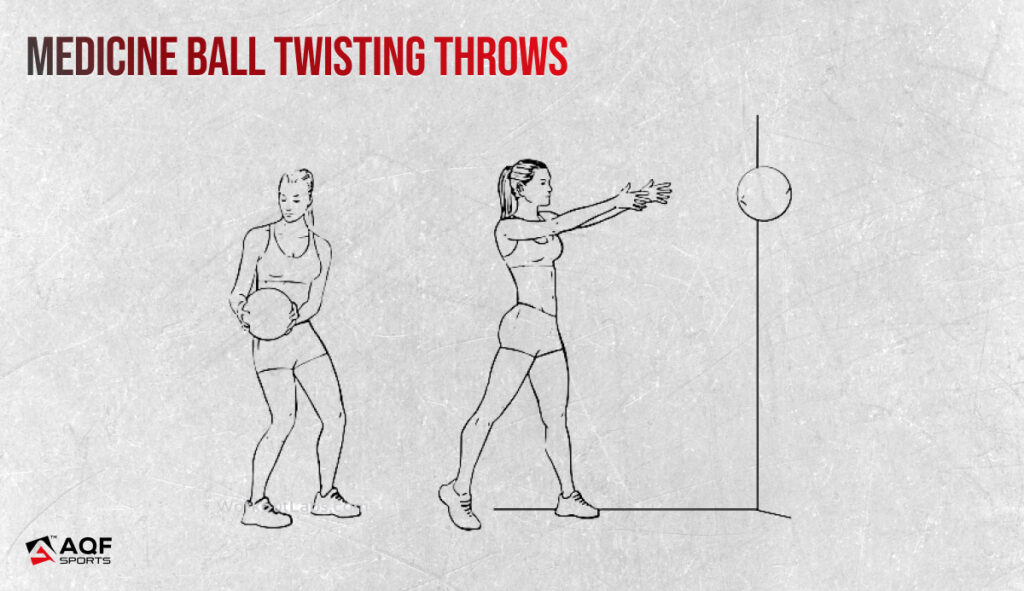
- Heavy Bag Rotation Drill: Practice throwing hooks and uppercuts on a heavy bag, focusing on maximizing rotational power with each punch.
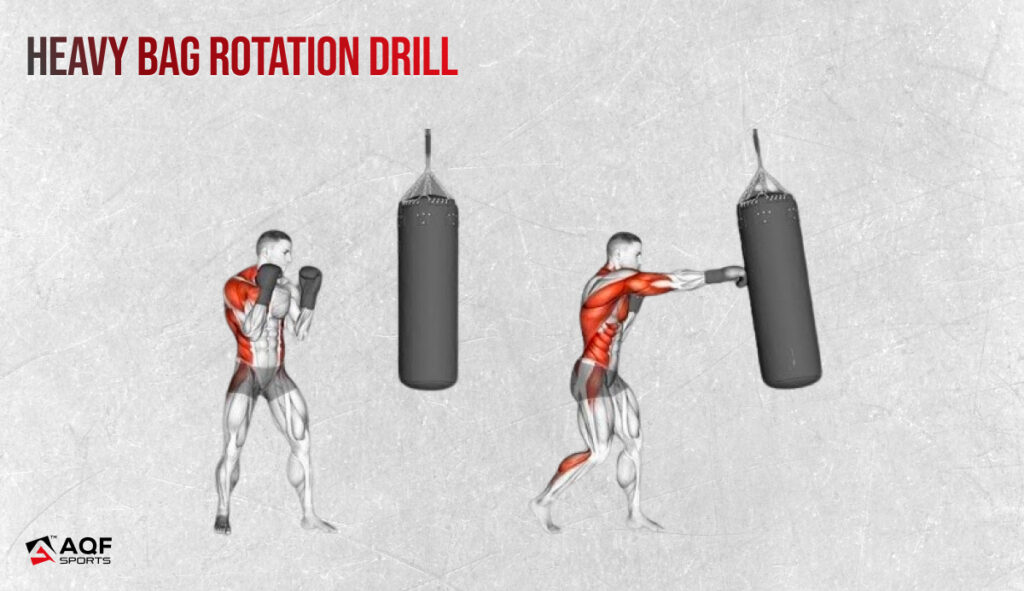
Rotational Power Development Session (20-30 mins):
- Warm-up: 5 minutes of shadowboxing incorporating rotational movements.
- Drill 1: 10 minutes of medicine ball twisting throws.
- Drill 2: 10 minutes of heavy bag work, focusing on rotational power punches.
Wear boxing gloves for a better training experience.
#2 Efficient Transfer of Weight:
Techniques:
- Cross and Straight Weight Transfer: Initiate the punch with your rear foot, rotate your body, and transfer weight forward onto the lead foot for crosses and straights.
- Timing Weight Transfer: Ensure synchronized movement, shifting weight as the punch lands, maximizing impact.
Drills:
- Band Step and Punch Drill: Practice stepping into punches while focusing on transferring weight smoothly from the rear to lead foot for crosses and straights.
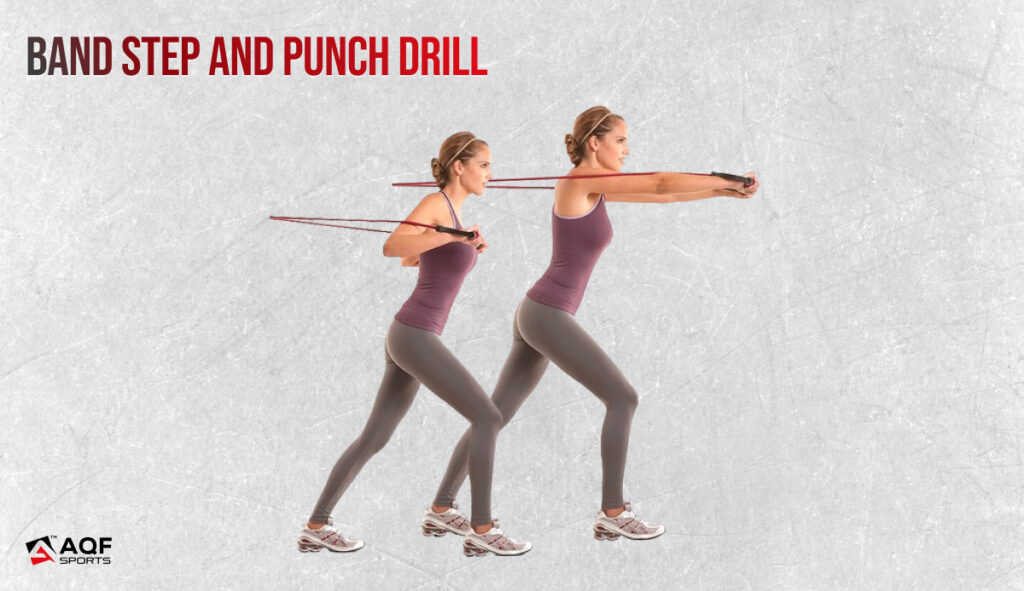
- Mirror Drill – Weight Transfer: Stand in front of a mirror and observe weight shifting while throwing crosses and straights.
Weight Transfer Mastery Session (20-30 mins):
- Warm-up: 5 minutes of light jogging or skipping.
Suggested Read: 2 Minute Back Warm-Up Exercises to Crank Up the Muscle Heat
- Drill 1: 10 minutes of step and punch exercises, concentrating on weight transfer.
- Drill 2: 10 minutes of mirror drill, focusing on observing and correcting weight distribution during punches.
#3 Snap in Punches for Speed and Power:
Techniques:
- Quick Recoil after Extension: Focus on snapping your punches back to guard position immediately after extension, using the speed of retraction to generate added power.
- Engaging the Core: Engage your core muscles during the snap-back motion to enhance the whip-like force.
Drills:
- Speed Bag Snapping: Utilize the speed bag, emphasizing quick and precise punches while snapping them back swiftly after each hit.

- Partner Mitt Work – Snap Punches: Work with a partner using focus mitts, emphasizing the snap-back motion after extending punches.

Snap Punch Development Session (20-30 mins):
- Warm-up: 5 minutes of dynamic stretching.
- Drill 1: 10 minutes of speed bag training, focusing on snapping punches.
- Drill 2: 10 minutes of partner mitt work, emphasizing snap punches and quick retraction.
Develop Unpredictable Boxing Movements
#1 Fakes and Body Feints
Practice shifting weight subtly to fake movements, making opponents react prematurely.
Drills:
- Partner Drill – Feint and Counter: Work with a partner; take turns throwing feints and observing reactions. Practice countering each other’s feints.
- Double Jab Feint Drill: Throw a double jab but feint the second jab, observing how opponents react to different timing.
Session Structure:
- Drill Session (20-30 mins):
- Warm-up: 5 minutes of skipping rope or light jogging.
- Drill 1: 10 minutes of partner feint and counter practice.
- Drill 2: 10 minutes of double jab feinting with a mirror or partner.
#2 Improve Angle Changes and Pivot Work
Master pivoting on your lead foot to swiftly change angles and create openings
Drills:
- Pivot and Strike Drill: Pivot on lead foot while throwing punches to work on angles. Rotate around a stationary target while maintaining strikes.
- Circle Movement Drill: Move in circles around a partner or bag, alternating clockwise and counterclockwise movements, adding strikes intermittently.
- Mirror Drills: Stand in front of a mirror and practice pivot movements, observing and correcting form.
Footwork Drill Session (20-30 mins):
- Warm-up: 5 minutes of dynamic stretching.
- Drill 1: 10 minutes of pivot and strike exercises.
- Drill 2: 10 minutes of circle movement drills with punches.
#3 Perform Footwork Drills
Experiment with skipping steps, stutter steps, and sudden direction changes to keep opponents off-balance.
Drills:
- Agility Ladder Variations: Perform ladder drills incorporating irregular steps, lateral movements, and directional changes.
- Reaction Ball Exercises: Use a reaction ball, bouncing it against a wall and reacting with unpredictable footwork movements.
Footwork Variation Session (20-30 mins):
- Warm-up: 5 minutes of light jogging or skipping.
- Drill 1: 10 minutes of agility ladder variations.
- Drill 2: 10 minutes of reaction ball exercises.

Feints and Setups:
#1 Mix Feints with Real Attacks:
Techniques:
- Double Jab Feint into Straight Right: Feint a double jab and follow up with a real straight right, taking advantage of your opponent’s reaction to the initial feint.
- Feint Uppercut to Set up a Hook: Feint an uppercut and immediately pivot to deliver a powerful hook, exploiting the opening created by the feint.
Drills:
- Mirror Drill – Feint and Strike: Stand in front of a mirror and practice alternating between feints and real strikes. Observe your own reactions and work on fluid transitions.
- Partner Pad Work: Use pads with a partner, alternating between feints and actual punches to refine timing and accuracy.
Feint-Attack Integration Session (20-30 mins):
- Warm-up: 5 minutes of shadowboxing incorporating feints.
- Drill 1: 10 minutes of mirror drill focusing on feint-real attack combinations.
- Drill 2: 10 minutes of partner pad work, alternating feints and actual strikes.
#2 Feint Combinations:
Techniques:
- Fake Cross to Lead Hook Combo: Begin with a fake cross, then swiftly transition to a lead hook, surprising opponents who anticipate the follow-through on the cross.
- Feint Jab-Cross Combo into Uppercut-Hook: Feint a jab-cross combo but switch to an uppercut-hook combination to catch opponents expecting a different sequence.
Drills:
- Combination Change Drill: Practice a set combination but change the final punches with feints, then execute different real strikes to keep the opponent guessing.
- Reaction Drill with Coach or Partner: Have a coach or partner call out combinations randomly; perform feint combinations as directed.
Feint Combination Variations Session (20-30 mins):
- Warm-up: 5 minutes of dynamic stretching.
- Drill 1: 10 minutes of combination change drill, focusing on feinting and transitioning to varied real combinations.
- Drill 2: 10 minutes of reaction drills with a coach or partner, incorporating feint combinations.
#3 Use Feints to Draw Counters:
Techniques:
- Feint to Draw Jab Counter – Counter with Overhand Right: Feint to provoke a jab counter from the opponent, then slip outside and counter with a powerful overhand right.
- Feint a Step-In – Counter with Body Shot: Feint a step-in, prompting the opponent to cover up, then quickly dip and deliver a body shot to capitalize on their reaction.
Drills:
- Counter Feint Drill: Initiate feints and encourage partners to counter; practice countering their counters effectively.
- Circle and Draw Drill: Move around a partner and use feints to entice counters; work on countering their reaction strategically.
Counter Feint Practice Session (20-30 mins):
- Warm-up: 5 minutes of light shadowboxing incorporating feints.
- Drill 1: 10 minutes of counter feint drills with a partner.
- Drill 2: 10 minutes of circle and draw drill, focusing on using feints to draw specific counters and countering effectively.
Implement Strategic Breathing Techniques:
#1 Practice Controlled Breathing During Intense Workouts:
Techniques:
- Rhythmic Breathing: Inhale during less strenuous movements, exhale during strikes or strenuous actions to maintain a steady rhythm.
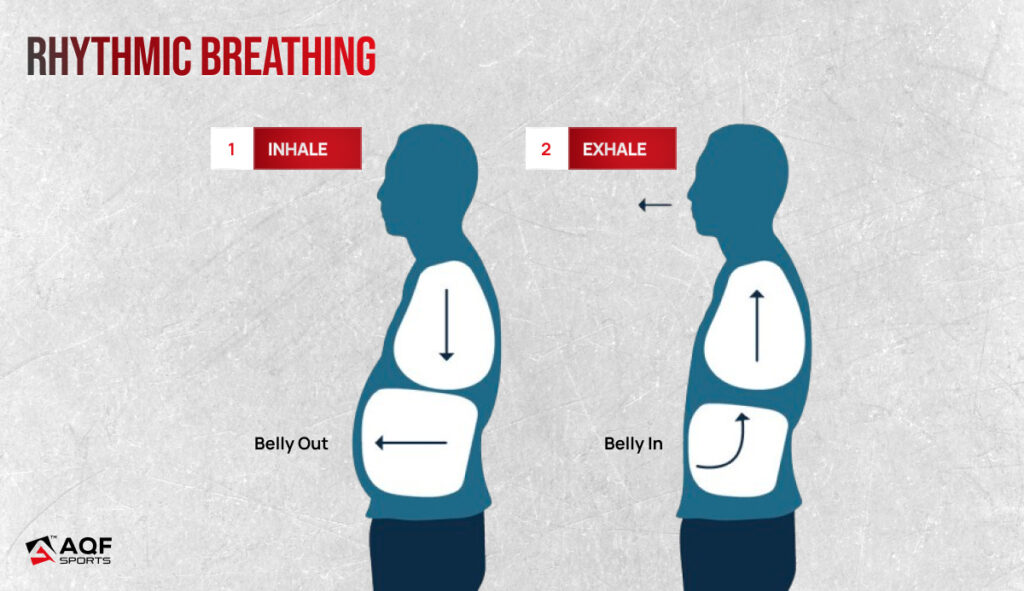
- Box Breathing: Inhale for a count of 4, hold for 4, exhale for 4, hold for 4, repeating the cycle.
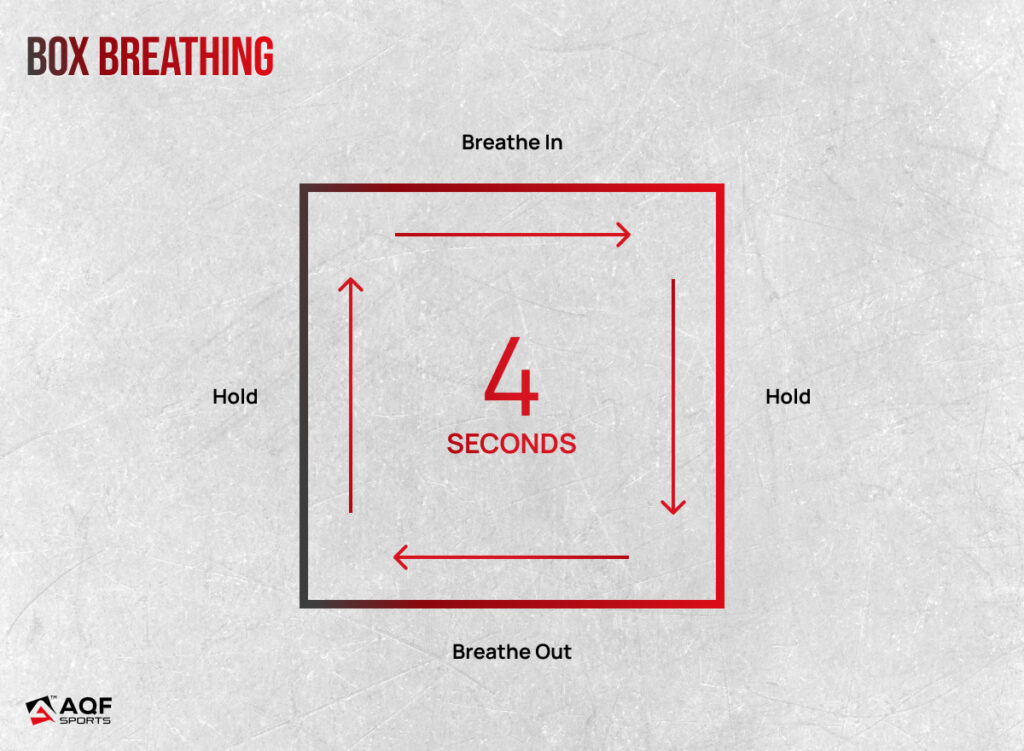
#2 Use Breathing to Stay Relaxed:
Techniques:
- Diaphragmatic Breathing: Focus on breathing deeply into the diaphragm, allowing the abdomen to expand on inhale and contract on exhale.
- Boxers’ Breath: Breathe in deeply through the nose, exhale audibly through the mouth to release tension.
#3 Employ Breathing Patterns for Recovery:
Techniques:
- Deep Belly Breaths: Inhale deeply through the nose, expanding the belly, and exhale fully, allowing for complete relaxation.
- Interval Breathing: Alternate between short, rapid breaths for energy and longer, controlled breaths for relaxation during recovery periods.
Breathing Focus Session (20-30 mins):
- Warm-up: 5 minutes of light cardio, focusing on synchronized breathing.
- Drill 1: 10 minutes of shadow boxing with rhythmic breathing, gradually increasing intensity.
- Drill 2: 10 minutes of interval training, alternating between intense bursts and controlled recovery, focusing on varied breathing techniques.
Supporting Practices:
- Breathing Diaries: Keep a journal to track progress in maintaining controlled breathing during workouts and sparring sessions.
- Feedback and Observation: Request feedback from trainers or partners on your breathing patterns during training, ensuring proper techniques under stress.
Recovery and Regeneration:
#1. Schedule Active Recovery Days:
- Light Exercises: Engage in low-impact activities like cycling, walking, or gentle stretching to promote blood circulation without straining muscles.
- Yoga or Pilates: Participate in sessions focusing on flexibility, balance, and gentle muscle engagement, aiding in recovery without causing fatigue.
Tips:
- Foam Rolling: Incorporate foam rolling sessions to alleviate muscle soreness and improve flexibility, enhancing recovery between intense training days.
- Swimming or Hydrotherapy: Take advantage of water-based exercises or contrast showers to reduce inflammation and promote recovery.
#2. Prioritize Sleep and Rest:
- Sleep Hygiene: Create a sleep-friendly environment with a cool, dark, and quiet room, ensuring uninterrupted rest for the recommended 7-9 hours.
- Consistent Sleep Schedule: Maintain a consistent sleep routine, going to bed and waking up at the same time daily to regulate the body’s internal clock.
Tips:
- Nighttime Routine: Establish a pre-sleep routine, including relaxation techniques like reading, gentle stretching, or meditation to prepare the body for restful sleep.
- Napping Strategically: Incorporate short power naps (20-30 minutes) to boost energy levels without disrupting nighttime sleep patterns.
#3. Hydration and Nutrition:
- Hydration: Consume water regularly throughout the day, monitoring urine color to ensure adequate hydration. Electrolyte-rich beverages aid in replenishing lost minerals during workouts.
- Nutritious Diet: Focus on balanced meals with adequate protein, healthy fats, and complex carbohydrates to support muscle recovery and energy replenishment.
Tips:
- Post-Workout Nutrition: Consume a meal or snack containing protein and carbohydrates within 30-60 minutes after training to facilitate muscle repair and glycogen replenishment.
- Supplementation: Consider supplements like BCAAs (Branched-Chain Amino Acids) or tart cherry juice known for their potential in reducing muscle soreness and aiding recovery.
Suggested Read: How Diet and Exercise Work Together for Lasting Health and Weight
Recovery Day Structure (Planned Weekly):
- Active Recovery Activity: 30-45 minutes of light cycling or yoga.
- Restorative Practice: 15-20 minutes of foam rolling or hydrotherapy.
- Mental Rejuvenation: 10-15 minutes of meditation or deep breathing exercises.
Implement Specific Resistance Training:
#1. Shadow Boxing with Weights:
- Shadowboxing with Light Dumbbells: Incorporate 1-2 lb dumbbells into shadowboxing sessions. Focus on maintaining proper form and speed while adding resistance to punches.

- Weighted Punch Combos: Perform sets of punch combinations with light weights, emphasizing controlled movements and full extension of punches.
Shadow boxing with Weights Session (10-15 mins):
- Warm-up: 5 minutes of dynamic stretching.
- Exercise 1: 5 minutes of shadow boxing with light dumbbells, focusing on form and speed.
- Exercise 2: 5-10 minutes of weighted punch combos, emphasizing full range of motion.
#2. Resistance Band Workouts for Speed:
- Band-Resisted Punches: Attach resistance bands to a fixed object and loop them around your wrists or arms. Practice various punch combinations, feeling the resistance and focusing on quick retraction.

- Band Sprints: Strap a resistance band around your waist and sprint forward, emphasizing explosive acceleration against the band’s resistance.

Resistance Band Speed Workout (15-20 mins):
- Warm-up: 5 minutes of jumping jacks or skipping.
- Exercise 1: 10 minutes of band-resisted punches, alternating between different combinations.
- Exercise 2: 5-10 minutes of band sprints or lateral movements against resistance.
#3. Medicine Ball Drills for Power:
- Medicine Ball Slams: Lift a medicine ball overhead and explosively slam it down, mimicking the motion of a powerful punch. Focus on engaging core muscles and generating force.
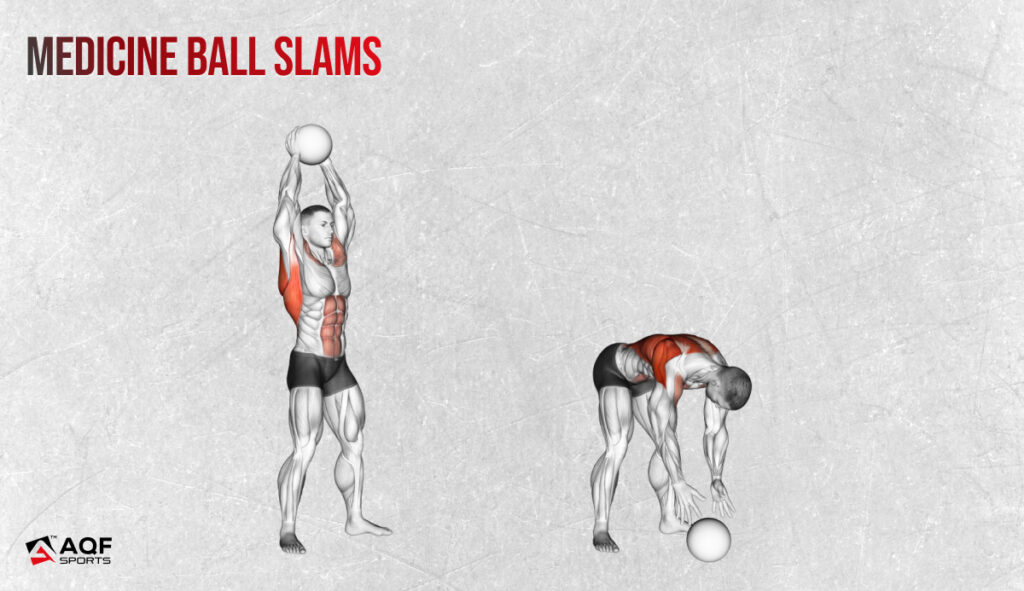
- Partner Medicine Ball Throws: Stand facing a partner; one throws the medicine ball forcefully while the other catches and repeats, emphasizing power and quick reflexes.
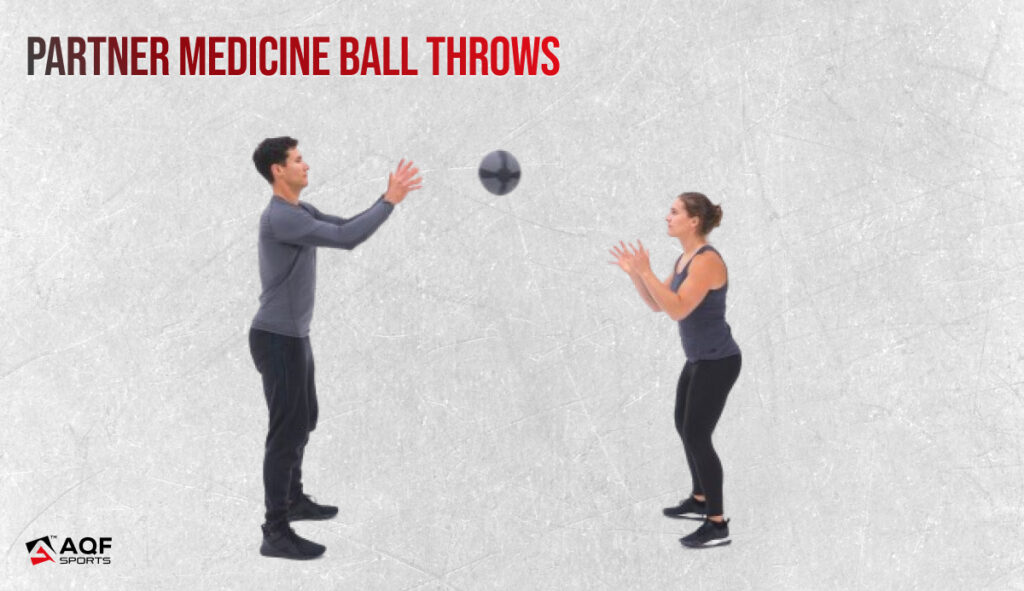
Medicine Ball Power Drills (15-20 mins):
- Warm-up: 5 minutes of dynamic movements (e.g., jumping jacks, high knees).
- Exercise 1: 10 minutes of medicine ball slams, focusing on explosive power and control.
- Exercise 2: 5-10 minutes of partner medicine ball throws, emphasizing speed and coordination.
Analyze Opponents’ Habits and Styles:
#1. Record and Analyze Fight Footage:
- Fight Footage Review: Record and watch opponents’ fights, focusing on their footwork, defensive movements, preferred combinations, and tendencies.
- Note Taking: Document patterns observed in their fighting style, including habits during different rounds, defensive maneuvers, and common offensive sequences.
- Focus on Footwork: Analyze how opponents move around the ring, their stance shifts, and how they initiate or respond to attacks.
- Timing Analysis: Pay attention to the timing of their punches, identifying any rhythmic patterns or tendencies in their attack sequences.
#2. Spar with Mimicked Styles:
- Partner Simulation: Spar with training partners who mimic specific opponents’ styles, replicating their footwork, defensive techniques, and preferred combinations.
- Role-Playing Sessions: Assign partners to emulate a particular opponent’s style during sparring sessions to develop strategies to counter that specific style.
Challenges in Boxing Skill Development:
Boxers encounter various challenges in their skill development, and understanding the scientific processes behind these hurdles can aid in overcoming them:
Technique:
Perfecting form and technique demands consistent practice and precision, challenging due to the intricate coordination required among muscle groups. Scientifically, this involves motor learning and neural adaptation, requiring repetitive training to optimize movement patterns.
Adapting to Diverse Styles:
Competitors’ varied styles necessitate adapting strategies. Neurologically, this requires cognitive processing and pattern recognition to swiftly adjust tactics, posing challenges in real-time during fights.
Endurance and Stamina:
Boxing is physically demanding. Enhancing endurance involves physiological adaptations, such as improved cardiovascular capacity and energy system development, essential for lasting through rounds.
The Bottomline
Boxing is a great skill but it comes with its unique challenges. Improving your movements and flexes will help you nail your opponent. Follow the tips shared above to become a pro boxer.
Discover More Topics





